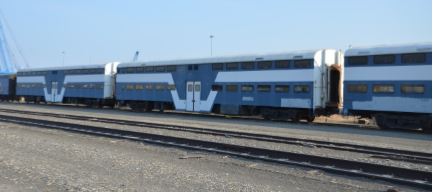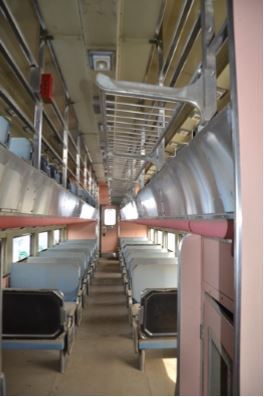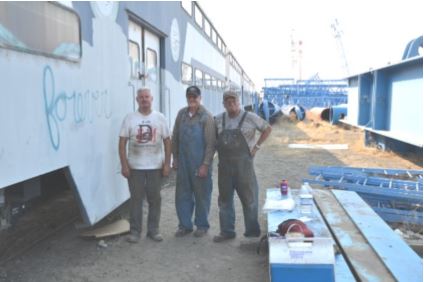 In late April an ad appeared on a rail equipment broker’s website for 3 former Southern Pacific passenger cars. This was a welcome surprise, since we have been actively looking for additional coaches in anticipation of our move to the Northwestern Pacific Railroad and the need for more passenger seats. It turns out the cars are Southern Pacific bi-level cars from their San Francisco-San Jose commute operation. This was exciting, since these were replacements for the heavyweight suburban coaches like the three we already have in our collection, and they fit our Mission Statement since they arrived just at the end of the steam era on the Peninsula.
In late April an ad appeared on a rail equipment broker’s website for 3 former Southern Pacific passenger cars. This was a welcome surprise, since we have been actively looking for additional coaches in anticipation of our move to the Northwestern Pacific Railroad and the need for more passenger seats. It turns out the cars are Southern Pacific bi-level cars from their San Francisco-San Jose commute operation. This was exciting, since these were replacements for the heavyweight suburban coaches like the three we already have in our collection, and they fit our Mission Statement since they arrived just at the end of the steam era on the Peninsula.
 The cars were originally SP 3714, SP 3720 and SP 3722 (they will carry these numbers in the GGRM collection). They were built by AFC in 1956 to Pulman-Standard plans. The gallery cars were retired by Southern Pacific in 1988 and sold to Rader Railcars in Oregon who converted some of them to dome cars for use in Alaska. The 3714, 3721 and 3722 were refurbished, but not modified, by the same owner and eventually sold to Tour Alaska LLC (part of the Princess cruise group) who used them to carry ship and ferry passengers between Whittier and Anchorage, Alaska during the summer cruise season.
The cars were originally SP 3714, SP 3720 and SP 3722 (they will carry these numbers in the GGRM collection). They were built by AFC in 1956 to Pulman-Standard plans. The gallery cars were retired by Southern Pacific in 1988 and sold to Rader Railcars in Oregon who converted some of them to dome cars for use in Alaska. The 3714, 3721 and 3722 were refurbished, but not modified, by the same owner and eventually sold to Tour Alaska LLC (part of the Princess cruise group) who used them to carry ship and ferry passengers between Whittier and Anchorage, Alaska during the summer cruise season.
Recognizing the need for additional passenger seats and encouraged by the low asking price, the Museum Board authorized Jim Bunger to go to Pasco, Washington, where the cars were stored, for an inspection.. Given that the cars were 61 years old and the broker had little history of their use or maintenance, it was anticipated that they might pose a major restoration effort. It was a surprise to learn that the cars had been stored at the Port of Pasco since 1993 or 1994. No one at the Port could remember when the cars were not there)! Actually, the cars operating years are much lower than their chronological years.
Unfortunately, cars sitting in rail yards for any period of time are often vandalized and experience missing parts, graffiti and broken widows. The initial inspection showed that this was not the case and that the cars could be moved to California without major mechanical work. Also, preparation for GGRM service would likely take much less time than other cars in our collection. After seeing the initial inspection report and following lengthy discussion, the Board voted to bid on all three cars. Negotiations with the seller over several days resulted in a final price at less than the original asking price of $20,000. per car. The sale was contingent on the cars being able to be moved without major mechanical work as determined by a railroad certified inspector. The next step was to hire a contractor who would be responsible for preparing the cars for movement and make arrangements with the railroad (BNSF) for the move. Were able to hire a contractor who is very familiar with vintage passenger cars and has significant experience getting them moved.
 Following discussions, it was determined that costs could be significantly lower if Museum volunteers helped with the prep work. In July, Jim Prettyleaf, Jay King and Jim Bunger drove to Pasco (a 14 hr. drive each way) to meet the contractor and begin work. The initial inspection by the contractor revealed a thin flange on one wheel which would prevent the car from being moved. Since this was covered in our offer to the seller, they were informed that we would not purchase that car at the asking price. The contractor estimated a change could be done in 4 hours if we could find a wheel set. Fortunately, a wheel set was located in St. Louis and a trucker was located to move it. Knowing the cost of the required repairs, it was decided to offer a lower price for the car. The sellers quickly accepted the offer and GGRM owned the cars. The major work done on the cars in Pasco was brake work. Each car has 8 brake cylinders and each had to be removed from under the car, disassembled, inspected, cleaned, lubricated, reassembled and returned to the car. Jim Prettyleaf and Jay King did most of this work much of which involved being on their backs on the ballast under the cars. In addition to the cylinder work, the brake valves were removed and shipped to a shop for overhaul and all brake hoses were replaced. During a 5 day trip in August, the same GGRM volunteers and the contractor completed the brake work and tested the brake systems in preparation for moving the cars to California. Fortunately, the cars are parked next door to one of the largest crane operators in the world. Lampson Crane was able to provide a crane and fork lift and the contractor completed the necessary wheel set change in 3 hours. The cars are now certified for movement and are sitting on the interchange track at the Port of Pasco waiting for the Museum to order the move. At this time, we are waiting for fencing to be complete at Shellville before ordering the move.
Following discussions, it was determined that costs could be significantly lower if Museum volunteers helped with the prep work. In July, Jim Prettyleaf, Jay King and Jim Bunger drove to Pasco (a 14 hr. drive each way) to meet the contractor and begin work. The initial inspection by the contractor revealed a thin flange on one wheel which would prevent the car from being moved. Since this was covered in our offer to the seller, they were informed that we would not purchase that car at the asking price. The contractor estimated a change could be done in 4 hours if we could find a wheel set. Fortunately, a wheel set was located in St. Louis and a trucker was located to move it. Knowing the cost of the required repairs, it was decided to offer a lower price for the car. The sellers quickly accepted the offer and GGRM owned the cars. The major work done on the cars in Pasco was brake work. Each car has 8 brake cylinders and each had to be removed from under the car, disassembled, inspected, cleaned, lubricated, reassembled and returned to the car. Jim Prettyleaf and Jay King did most of this work much of which involved being on their backs on the ballast under the cars. In addition to the cylinder work, the brake valves were removed and shipped to a shop for overhaul and all brake hoses were replaced. During a 5 day trip in August, the same GGRM volunteers and the contractor completed the brake work and tested the brake systems in preparation for moving the cars to California. Fortunately, the cars are parked next door to one of the largest crane operators in the world. Lampson Crane was able to provide a crane and fork lift and the contractor completed the necessary wheel set change in 3 hours. The cars are now certified for movement and are sitting on the interchange track at the Port of Pasco waiting for the Museum to order the move. At this time, we are waiting for fencing to be complete at Shellville before ordering the move.
What next: As always, there is significant work to be done to place any piece of equipment in service; especially something that has been sitting for 20+ years. The first work on these cars will be to remove several inches of dust that coats everything followed by scrubbing seats, walls and floors. Along with cleaning, the generators will need to be serviced or overhauled, the HVAC systems upgraded, all electrical systems tested and perhaps a paint job.
Mechanical and Historical Details
Built by American Car & Foundry, Co. to Pullman Plan 85-MLC-2, Lot 04-4787 (21 cars)
Delivered to Southern Pacific Co. Early 1957 and placed in Peninsula commute service.
Paint scheme: As delivered, 2 tone gray (later all cars were painted Lark Gray).
Seating: 2x2 vinyl walkover on main floor, single walkover on upper floor
Bathrooms: single general toilet in each car w/holding tank
Power: Detroit 3-71 generator for HVAC
Glazing: FRA type 2 glazing.
Door windows: polycarbonate
Brakes: Budd disc w/D-22 valves
Lighting: Incandescent reading lights at each seat


